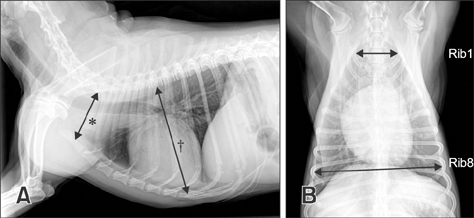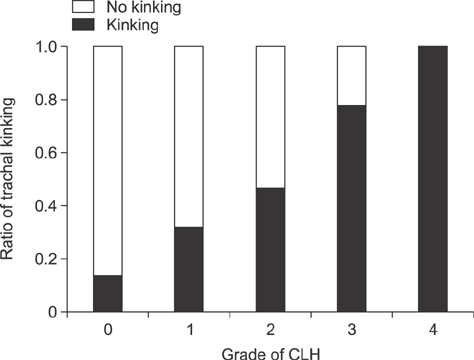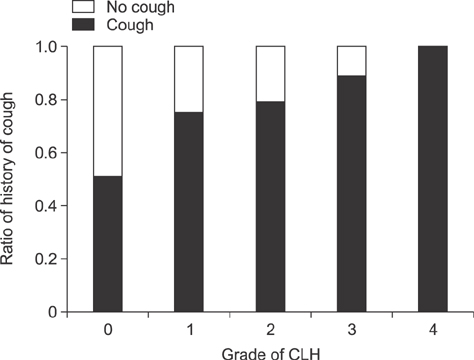J Vet Sci.
2017 Dec;18(4):499-505. 10.4142/jvs.2017.18.4.499.
Fluoroscopic characteristics of tracheal collapse and cervical lung herniation in dogs: 222 cases (2012–2015)
- Affiliations
-
- 1College of Veterinary Medicine and the Research Institute for Veterinary Science, Seoul National University, Seoul 08826, Korea. heeyoon@snu.ac.kr
- KMID: 2398509
- DOI: http://doi.org/10.4142/jvs.2017.18.4.499
Abstract
- This retrospective study included 222 dogs suspected to have tracheal collapse (TC) and examined between 1 January 2012 and 31 December 2015. Fluoroscopic and radiographic images and medical records were evaluated to investigate the fluoroscopic characteristics of TC and cervical lung herniation (CLH), and to determine their relationships to various influencing. Grade of TC, existence of tracheal kinking, location of CLH (right or left side), and grade of CLH were evaluated fluoroscopically. One hundred ninety-nine dogs (89.6%) were diagnosed with TC. Presence of TC was not associated with the patients' cough history; however, CLH was positively correlated with cough history (odds ratio [OR], 2.896; 95% confidence interval [CI], 1.556 to 5.390) and was affected by tracheal kinking (OR, 3.841; 95% CI, 1.884 to 7.831). Chronic cough was not related with CLH. Since TC can be observed in patients without a history of cough, presence of TC should be ruled out by using physical examination and diagnostic imaging. Although CLH is associated with a history of cough, it is a common appearance in dogs, and transient coughing can elicit CLH in patients without a history of cough.
Keyword
MeSH Terms
Figure
Cited by 1 articles
-
A retrospective study of theophylline-based therapy with tracheal collapse in small-breed dogs: 47 cases (2013–2017)
So-Young Jeung, Sang-June Sohn, Ju-Hyun An, Hyung-Kyu Chae, Qiang Li, Mincheol Choi, Junghee Yoon, Woo-Jin Song, Hwa-Young Youn
J Vet Sci. 2019;20(5):. doi: 10.4142/jvs.2019.20.e57.
Reference
-
1. Austin J, Ali T. Tracheomalacia and bronchomalacia in children: pathophysiology, assessment, treatment and anaesthesia management. Paediatr Anaesth. 2003; 13:3–11.
Article2. Bhalla M, Leitman BS, Forcade C, Stern E, Naidich DP, McCauley DI. Lung hernia: radiographic features. AJR Am J Roentgenol. 1990; 154:51–53.
Article3. Bidstrup P, Nordentoft JM, Petersen B. Hernia of the lung. Brief survey and report of two cases. Acta Radiol Diagn (Stockh). 1966; 4:490–496.4. Choi R, Suh SI, Hyun C. Cervical lung lobe herniation in a Pekingese dog. Korean J Vet Res. 2015; 55:153–154.
Article5. Coleman MG, Warman CGA, Robson MC. Dynamic cervical lung hernia in a dog with chronic airway disease. J Vet Intern Med. 2005; 19:103–105.
Article6. Coutu MP, Rousset N, Cosford K. Dynamic cervical lung herniation causing dysphagia in a puppy. Vet Rec Case Rep. 2015; 3:e000193.
Article7. Dallman MJ, McClure RC, Brown EM. Histochemical study of normal and collapsed tracheas in dogs. Am J Vet Res. 1988; 49:2117–2125.8. Evans HE, de Lahunta A. The respiratory system. Miller's Anatomy of the Dog. 4th ed. St. Louis: Elsevier Saunders;2013. p. 338–360.9. Fenichel NM, Epstein BS. Pulmonary apical herniations. AMA Arch Intern Med. 1955; 96:747–751.
Article10. Gonzalez del Rey J, Cunha C. Cervical lung herniation associated with upper airway obstruction. Ann Emerg Med. 1990; 19:935–937.
Article11. Guglielmini C, De Simone A, Valbonetti L, Diana A. Intermittent cranial lung herniation in two dogs. Vet Radiol Ultrasound. 2007; 48:227–229.
Article12. Howkins EC. Respiratory system disorders. In : Nelson RW, Couto CG, editors. Small Animal Internal Medicine. 5th ed. St. Louis: Elsevier Mosby;2014. p. 309–313.13. Hawkins EC, Clay LD, Bradley JM, Davidian M. Demographic and historical findings, including exposure to environmental tobacco smoke, in dogs with chronic cough. J Vet Intern Med. 2010; 24:825–831.
Article14. Hayward N, Schwarz T, Weisse C. The trachea. In : Schwarz T, Johnson V, editors. BSAVA Manual of Canine and Feline Thoracic Imaging. Gloucester: British Small Animal Veterinary Association;2008. p. 217–220.15. Jepsen-Grant K, Pollard RE, Johnson LR. Vertebral heart scores in eight dog breeds. Vet Radiol Ultrasound. 2013; 54:3–8.
Article16. Lightwood RG, Cleland WP. Cervical lung hernia. Thorax. 1974; 29:349–351.
Article17. McAdams HP, Gordon DS, White CS. Apical lung hernia: radiologic findings in six cases. AJR Am J Roentgenol. 1996; 167:927–930.
Article18. Moncada R, Vade A, Gimenez C, Rosado W, Demos TC, Turbin R, Venta L. Congenital and acquired lung hernias. J Thorac Imaging. 1996; 11:75–82.
Article19. Morel-Lavallée A. [Hernias of the lung]. Bull Mem Soc Chir Paris. 1847; 1:75–95. French.20. Nafe LA, Robertson ID, Hawkins EC. Cervical lung lobe herniation in dogs identified by fluoroscopy. Can Vet J. 2013; 54:955–959.21. Rahman M, Buchan KG, Mandana KM, Butchart EG. Bilateral cervical lung hernia with T1 nerve compression. Ann Thorac Surg. 2006; 81:716–718.
Article22. Thompson JS. Cervical herniation of the lung. Report of a case and review of the literature. Pediatr Radiol. 1976; 4:190–192.
Article
- Full Text Links
- Actions
-
Cited
- CITED
-
- Close
- Share
- Similar articles
-
- The Safety and efficacy of a new self-expandable intratracheal nitinol stent for the tracheal collapse in dogs
- Surgical outcomes in dogs with tracheal collapse treated with a novel crossand-hook braided endoluminal stent
- Ultrasonographic evaluation of tracheal collapse in dogs
- Cervical lung lobe herniation in a Pekingese dog
- CT of lobar collapse





